Scientists have created the largest ever supermassive black hole map. The map, which is featured in a paper in The Astrophysical Journal, showcases more than 1.3 million quasars found in space and time. The furthest black hole featured in the map existed when the universe was only 1.5 billion years old, over 12 billion years ago.
The map itself is showcased in a video within the paper, and it’s somewhat terrifying to think of all those supermassive black holes bounding their way through our universe, including some rogue black holes that might be barreling through space and time with no galaxy to hold them down.
Scientists build the supermassive black hole map using data gathered by the European Space Agency’s (ESA) Gaia space telescope. Gaia has helped map the stars within our galaxy, providing data for several mapping projects since it began service in 2013.

The researchers say they were even able to make measurements of how matter clusters together throughout the early universe using the data. And that some of the measurements were as precise as those found in other major survey projects. That’s all really exciting because it means we aren’t just clumping the data together without any idea of how it actually fits together.
Of course, mapping all of the supermassive black holes in the universe is no small feat. As such, it’s definitely something that deserves our applause. As astronomers work to locate distant quasars like the ones that power this map, we can better understand how the universe expanded, which could answer some long-lasting questions that astronomers have had about the cosmos.
The data used was taken from Gaia’s third data release, as well as data that was captured by NASA’s Wide-Field Infrared Survey Explorer and Sloan Digital Sky Survey. This all comes together to create a beautiful yet terrifying map that may give you nightmares just because of how many black holes there are in the universe.








